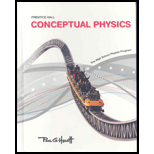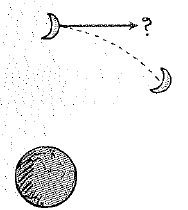
Concept explainers
The moon 'falls' 1.4 mm each second. Does this mean that it gets 1.4 mm closer to Earth each second? Would it get closer if its tangential velocity were reduced? Explain.

To identify: Whether the moon is coming closer to Earth each second for the given specification. Also, will the moon come closer to Earth if its tangential velocity is reduced.
Answer to Problem 35A
The moon does not gets
The moon gets closer to Earth if its tangential velocity is reduced.
Explanation of Solution
Introduction:
The Moon’s tangential velocity is the parallel to the Earth’s surface and perpendicular to of the Earth’s gravitational pull.
The gravitational pull of Earth provides centripetal force which is required for the revolution of moon around the Earth.
The Moon always moves in a fixed orbit around the surface of the Earth, under the influence of the Earth’s gravitational pull.The “Moon falls
The Moon’s tangential velocity is sufficient enough to maintain the Moon in the fixed orbit.When the Moon’s tangential velocity is reduced, the Moon will leave the orbit and falls towards the Earth as the balance between its centripetal force and the Earth’s gravitational pull is disturbed.Hence, the Moon comes closer to the Earth if its tangential velocity is reduced.
Conclusion:
Thus, the moon does not gets
Also, the moon gets closer to Earth if its tangential velocity is reduced.
Chapter 13 Solutions
Conceptual Physics: The High School Physics Program
Additional Science Textbook Solutions
Physics for Scientists and Engineers: A Strategic Approach, Vol. 1 (Chs 1-21) (4th Edition)
Conceptual Physics (12th Edition)
Physics (5th Edition)
Sears And Zemansky's University Physics With Modern Physics
Life in the Universe (4th Edition)
 College PhysicsPhysicsISBN:9781305952300Author:Raymond A. Serway, Chris VuillePublisher:Cengage Learning
College PhysicsPhysicsISBN:9781305952300Author:Raymond A. Serway, Chris VuillePublisher:Cengage Learning University Physics (14th Edition)PhysicsISBN:9780133969290Author:Hugh D. Young, Roger A. FreedmanPublisher:PEARSON
University Physics (14th Edition)PhysicsISBN:9780133969290Author:Hugh D. Young, Roger A. FreedmanPublisher:PEARSON Introduction To Quantum MechanicsPhysicsISBN:9781107189638Author:Griffiths, David J., Schroeter, Darrell F.Publisher:Cambridge University Press
Introduction To Quantum MechanicsPhysicsISBN:9781107189638Author:Griffiths, David J., Schroeter, Darrell F.Publisher:Cambridge University Press Physics for Scientists and EngineersPhysicsISBN:9781337553278Author:Raymond A. Serway, John W. JewettPublisher:Cengage Learning
Physics for Scientists and EngineersPhysicsISBN:9781337553278Author:Raymond A. Serway, John W. JewettPublisher:Cengage Learning Lecture- Tutorials for Introductory AstronomyPhysicsISBN:9780321820464Author:Edward E. Prather, Tim P. Slater, Jeff P. Adams, Gina BrissendenPublisher:Addison-Wesley
Lecture- Tutorials for Introductory AstronomyPhysicsISBN:9780321820464Author:Edward E. Prather, Tim P. Slater, Jeff P. Adams, Gina BrissendenPublisher:Addison-Wesley College Physics: A Strategic Approach (4th Editio...PhysicsISBN:9780134609034Author:Randall D. Knight (Professor Emeritus), Brian Jones, Stuart FieldPublisher:PEARSON
College Physics: A Strategic Approach (4th Editio...PhysicsISBN:9780134609034Author:Randall D. Knight (Professor Emeritus), Brian Jones, Stuart FieldPublisher:PEARSON





